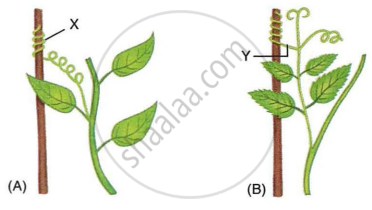Advertisements
Advertisements
प्रश्न
Study the diagrams given below and answer the following questions:

- Name the structures shown as X and Y in the figures (A) and (B), respectively.
- Write the functions performed by the structures X and Y.
- Name the phenomenon depicted and define it.
- How do the structures X and Y differ from each other?
- Give examples of the plants which show the said phenomenon.
उत्तर
- X - Stem Tendril
Y - Leaf Tendril - Stem and leaf tendrils assist the plant in ascending a support.
- Thigmotropism.
The growth movement of plant parts in response to touch stimulus is called thigmotropism. - The stem tendril (X) is the terminal outgrowth that facilitates the plant's ascent.
The leaf tendril (Y) is the entire leaf modified into tendrils to turn around the suitable host. - Sweet Pea
Vines and Cuscuta.
संबंधित प्रश्न
Give the scientific terms used to represent the Bending of roots towards water.
Which of the following is a growth movement and which is not?
- Folding up of leaves of sensitive plant on touching with hand.
- Folding up of petals of dandelion flower when light fades.
The bending of the stem of a plant towards a source of light is caused by the action of a phytohormone known as :
(a) abscisic acid
(b) auxin
(c) gibberellins
(d) cytokinin
A potted plant is growing in a transparent glass jar. In this plant, X and Y are the two growing parts having a lot of meristematic tissue. It is observed that the part X of this plant exhibits positive geotropism but negative phototropism. On the other hand, part Y of this plant exhibits negative geotropism but positive phototropism.
(a) Name the part X of plant.
(b) Name the part Y of plant.
(c) Which part of the plant, X or Y, will exhibit positive hydrotropism?
(d) Which part of the plant, X or Y, can have tendrils on it?
(e) Which phytohormone causes the part X to exhibit negative phototropism?
Name the stimulus which causes the following movements in plants.
phototropism, thigmotropism, hydrotropism and geotropism
The shoot system grows upward in response to ______.
The leaves of Mimosa are sensitive to ____________.
The opening and closing of the Moonflower is not a tropism because the movement in this is ______.
Why do stems show positive phototropism?
Name the stimulus which causes the following movement in plant:
phototropism
